25+ Common Cat Sleeping Positions Guide: What They Mean?
Why Cat Sleeping Positions and Their Meanings Matter?
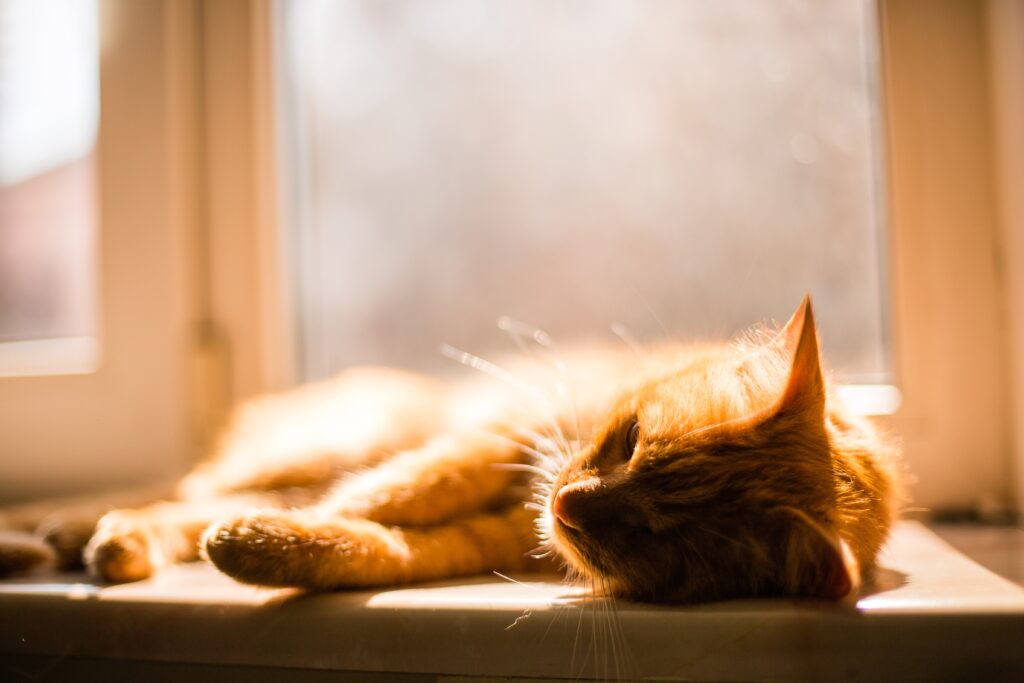
Cats have many different sleeping positions that can give us insight into their comfort level, mood, and even their health. It is important to read into these sleeping positions and patterns to get to know our furry friends better.
In this article, we will introduce more than 25 common cat sleeping positions and patterns to help you decode your cat’s slumber. Let’s begin!
Decoding Cat Sleeping: What Do These Positions Mean?
Curled Up/Crescent
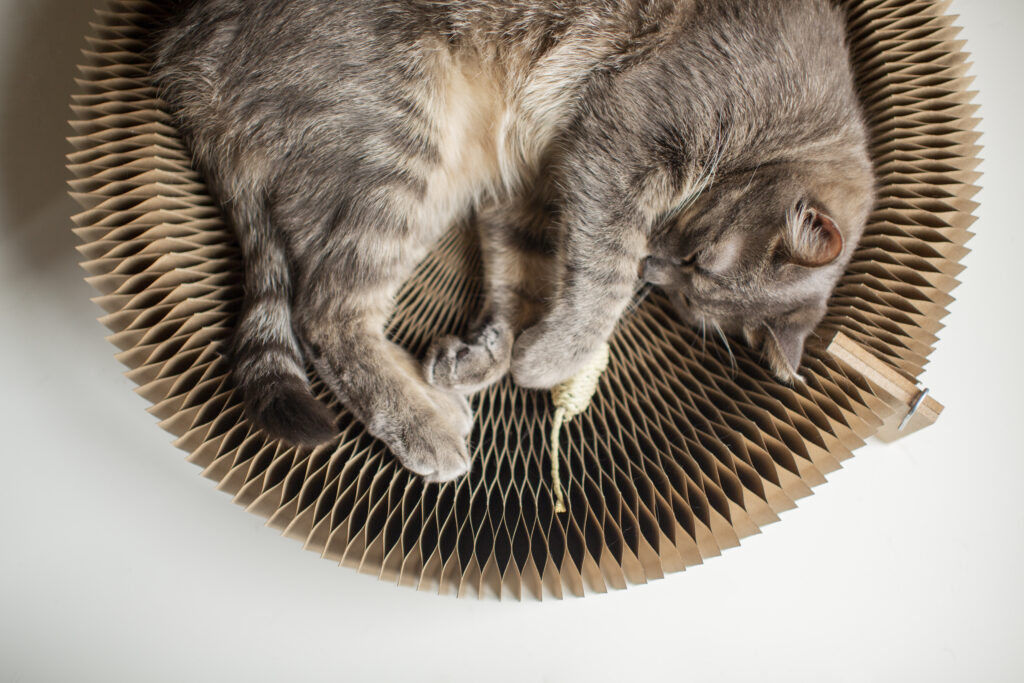
Cats have some cozy sleep positions, like the classic curled-up ball or crescent shape. These positions aren’t just comfy; they can be traced back to their wild instincts for staying safe. A playful variation is the cat shrimp pose, where kitties stretch out like shrimp because, well, it’s comfy! The crescent position is another favorite, mirroring the way wild cats keep vulnerable parts protected and retain the heat of their bodies. When they sleep in these positions, it’s all about staying warm and feeling secure. This is also one of the most natural sleeping positions for cats.
The meaning of this cat sleeping position is your cat finding comfort while mirroring ancient instincts for safety and warmth.
On the Back/ Belly up
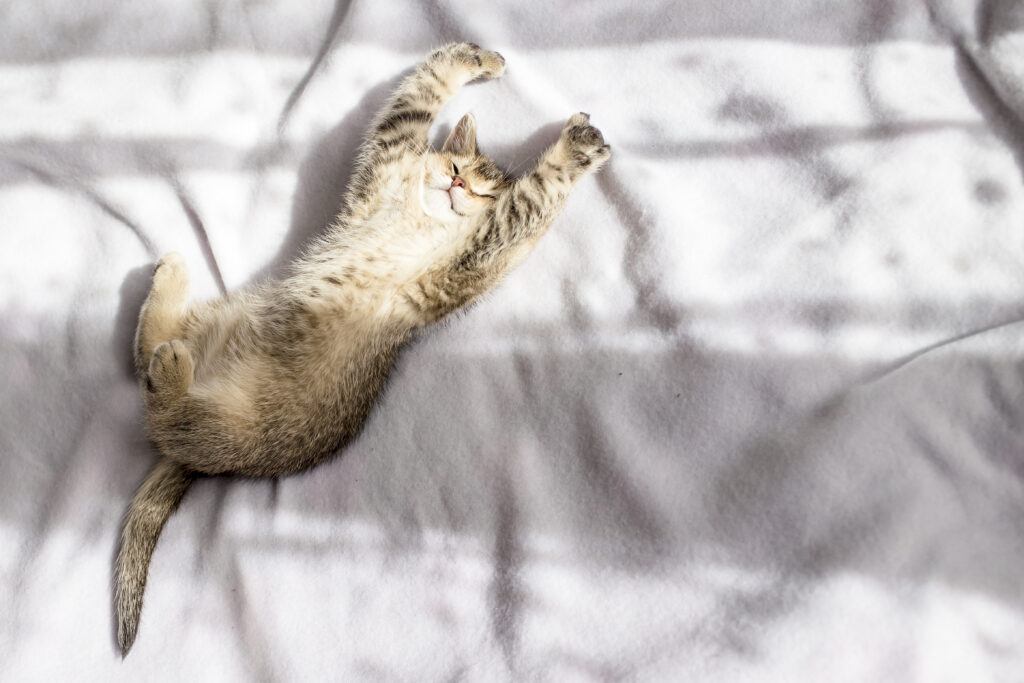
When cats are sleeping on their back, it’s a clear sign of trust and contentment as cats show their belly up. This position bares their belly, a vulnerable area, signaling they feel completely secure in their surroundings. Whether they stretch their legs out or curl them up, it’s all about that feeling of safety and relaxation.
This cat sleeping position indicates a deep bond between you and your cats as they feel they are in a safe environment. So, while it might be tempting to give that exposed belly a rub, most cats may still react defensively. When your kitty sprawls out like this, it’s her way of saying, “I’m safe, happy, and trusting of you.”
On the Side
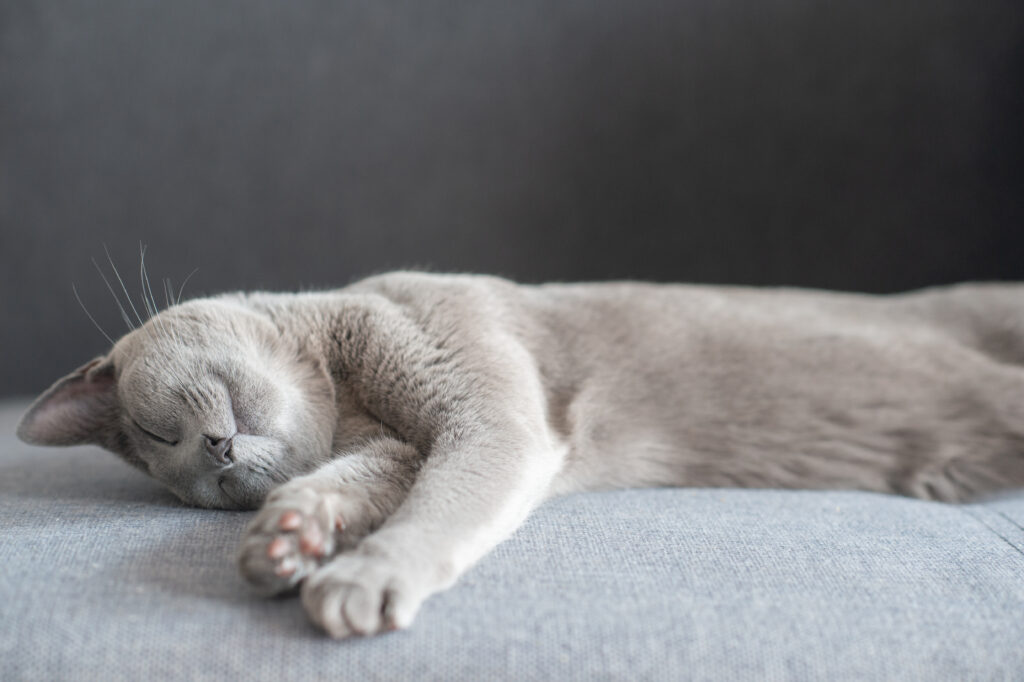
Cats stretching out on their side with their legs extended is a strong sign of trust and comfort. Like sleeping on their back, this position reveals their vital organs, showcasing their utmost confidence in you. Yet, it also provides them with an escape route if needed, a vestige of their prey animal instincts for added security during rest.
This sideways sleeping posture indicates a relaxed but alert kitty. Their exposed belly and outstretched limbs reflect contentment and trust in their environment. It’s like your cat saying, “I’m comfortable and safe with you.”
Cats may choose their sleeping position based on the temperature. Warmer cats may prefer this extended side sleeping stance. So, if your feline friend often rests with outstretched legs, it’s a testament to her trust, comfort, and perhaps a cozy atmosphere.
This cat sleeping position means feeling secure and relaxed with a side of readiness.
Cat Loaf Position
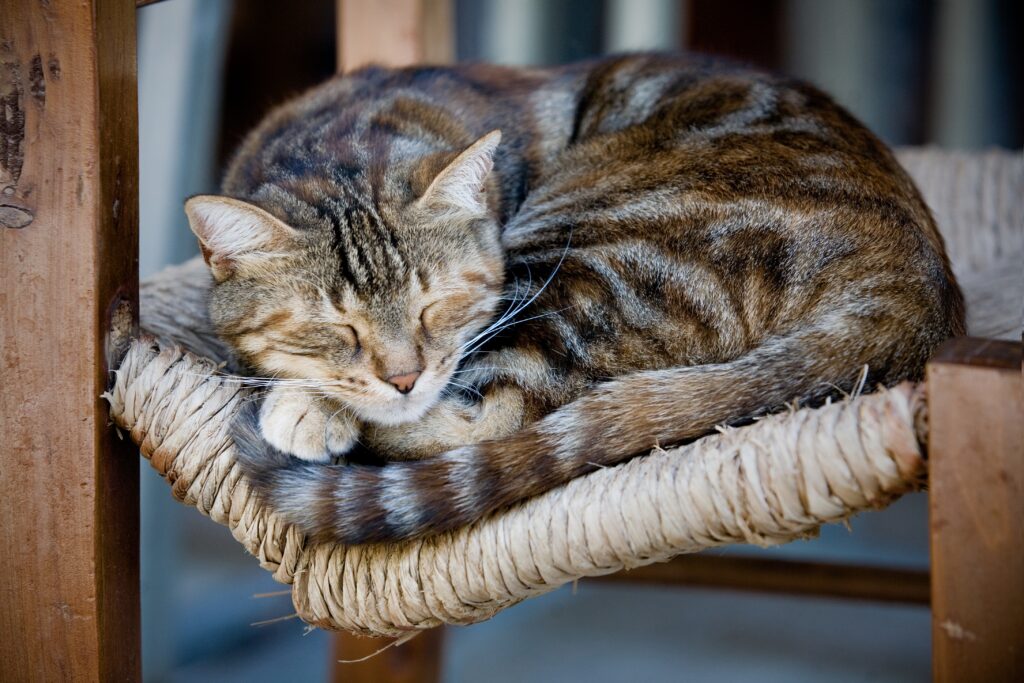
When cats curl their paws in their sleep, they take on the “Cat Loaf” position because they resemble a loaf of bread. In this posture, your cat sleeps with their body upright, paws, and tail tucked in, creating a square shape similar to a loaf of bread. This position helps conserve body heat and allows for quick reactions if needed. Cats may choose this position for various reasons, including seeking warmth or simply finding it comfortable.
The “loaf” position is a familiar sight to cat owners. It involves your cat tucking their front and back paws under their body, wrapping their tail around themselves, and keeping their head upright. When your cat assumes the “loaf,” it indicates relaxation while keeping them ready to spring into action if required.
Most cat owners are well acquainted with the iconic “loaf” position, where a cat sits upright, with their neatly tucked paws under their body. When cats sleep in this position, they safeguard their vital organs and stay alert, ready to react swiftly to any potential danger.
In a Box

Cats like to have snug spaces, often squeezing themselves into the tiniest boxes they can find. This behavior provides them with a sense of security. It is similar to how babies enjoy swaddling. While it’s endearing to watch, cats seeking small spaces for sleep, like under a bed, could be signaling stress.
Cats are naturally drawn to enclosed spaces as they offer a comforting shield against potential threats or dangers. Therefore, they prefer boxes – cozy hideaways where they can quietly observe their surroundings while remaining hidden. When your cat chooses to nap in a box, it’s a sign that they feel relaxed and secure.
In a Litter Box
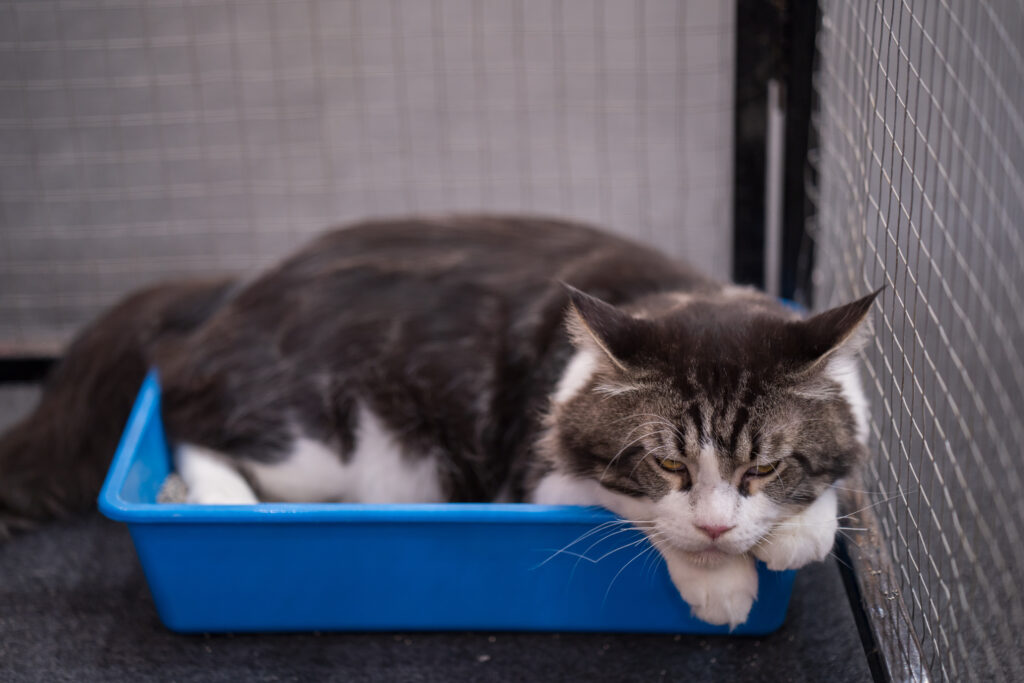
If you observe your cat suddenly taking up a resting spot in the litter box, it’s essential to consult a veterinarian as this behavior may signal a possible medical problem. Your cat could be suffering from urinary or digestive concerns such as constipation, diarrhea, urinary tract infections, or bladder blockage.
The litter box might become their chosen spot for older cats due to arthritis or cognitive issues. They could mistakenly consider it a resting place if they suffer from dementia. In some cases, your cats may seek the litter box as a safe haven. However, it’s not a behavior to encourage, as it could lead to health complications such as infections on different body parts.
With Eyes Open
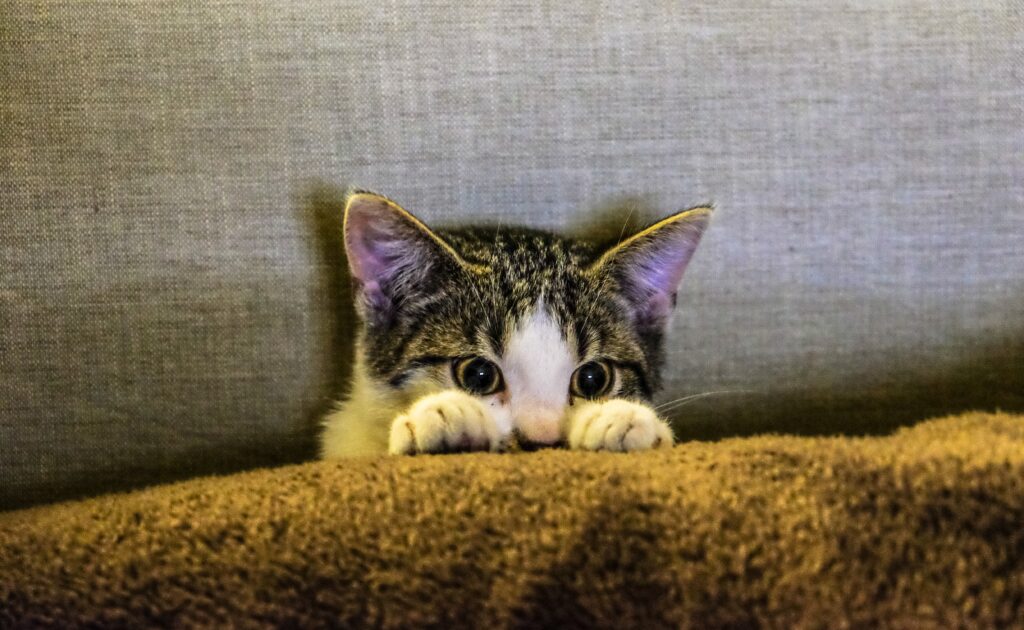
It’s not unusual for cats to sleep with their eyes partially or fully open. This habit, although it might appear weird to human, is absolutely normal and has its roots in their wild ancestry. Cats can partially close their eyelids, allowing them to rest while staying alert. This comes from their ancestors who had to remain prepared for potential threats, even during their slumber. While some cats nap with one eye open or both eyes half open due to their instinct to watch for danger, it’s still wise to rule out any underlying medical concerns.
If you notice a cat’s eye swelling and squinting, or your cat keeps pawing at their eye, or if the third eyelid is visible when they’re awake, it’s crucial to consult a veterinarian to ensure your feline friend’s well-being.
With Tongue Out
When your cat sleeps with their tongue out, or “the blep,” it’s an appealing sight that signifies their relaxation. This position suggests their jaw is loose, allowing the tongue to slip out naturally. Although it’s usually a normal sleeping behavior, it’s essential to keep an eye on your cat’s overall well-being.
If you notice signs of pain, drooling, or mouth bleeding on your cats, it could mean potential dental problems or other health issues. In such cases, you should contact your vet as soon as possible. Cats occasionally sleeping with their tongues out is typically nothing to worry about. During deep relaxation, their muscles loosen, causing their tongue to protrude slightly.
Sitting Up

Cats sitting up while sleeping can look hilariously human-like, but it’s a sign of their confidence in their environment. This posture shows their belly, indicating they feel safe and secure. Sitting up also makes it easier for cats to groom their bellies between naps and can provide additional support for their back muscles.
Though less common, cats may occasionally sleep in a sitting position, allowing them to rest while remaining alert to the surroundings. If you notice your cat often adopting this posture, it’s a sign that they want to stay vigilant even during their moments of rest.
Covering Face with Paws
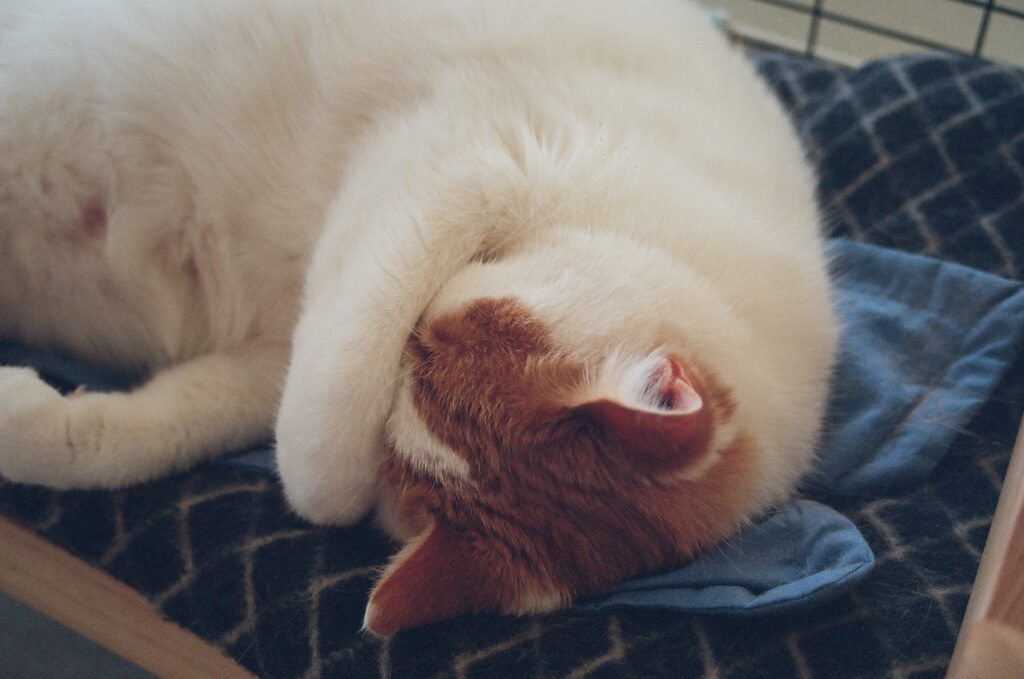
When your cat sleeps with their paws covering their eyes or paws across the face, it’s not just cute; there’s a practical reason behind it. This behavior provides insulation and warmth for both their paws and face. Their paws also act like a natural sleep mask, shielding their eyes from harsh light, dust, or pollen.
This adorable posture, often seen when your cat places a paw over their face, is a clear signal that they want some peaceful slumber without disturbances. It’s their way of saying, “Please don’t disturb me.” This position helps them block out light and noise, indicating they’re in a deep sleep and need some undisturbed rest. Cats commonly adopt this position to get a deep, uninterrupted sleep.
The Superman Pose
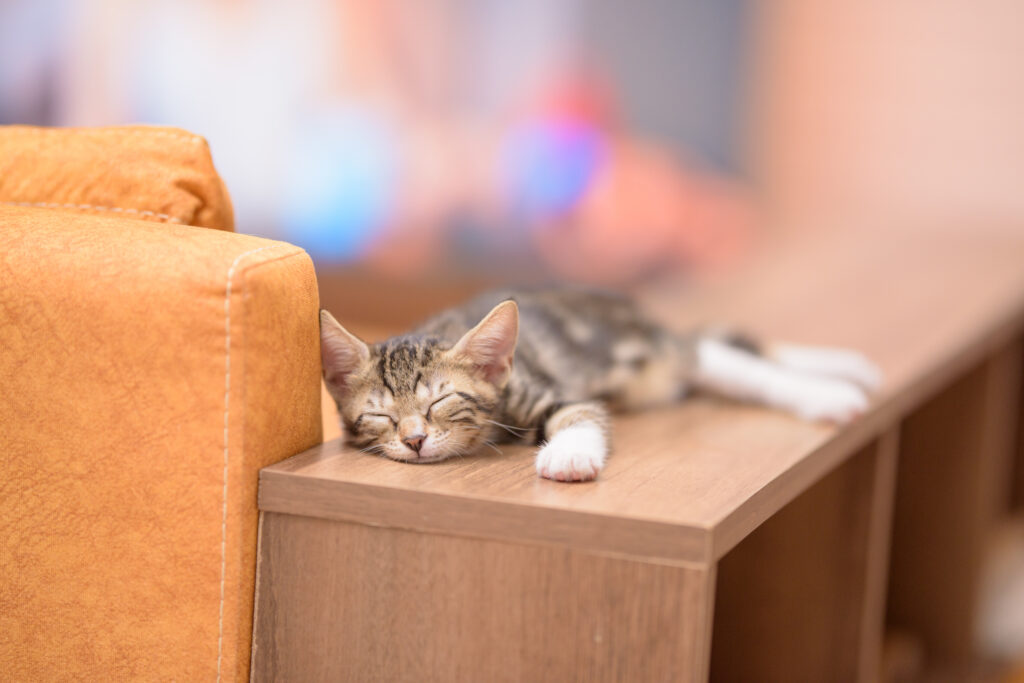
In the “superman” position, your cat lies flat on their belly. Their front legs and paws stretch forward, and their back legs and paws stretch backward, resembling Superman in flight. This posture allows them to stretch out, ensuring comfort and safety fully. When your cat often sleeps like this, it clearly indicates that they feel secure and relaxed in your home.
While in the Superman position, cats remain quite relaxed, even though all four paws are extended, ready for action if needed. This pose also offers some protection for their delicate belly. Cats tend to choose warm surfaces like a cozy blanket for this position, helping to maintain their body heat. On hotter days, they might opt for a cooler tile or hardwood floor to stay comfortable.
When your cat sleeps with their legs outstretched like Superman, it’s a strong signal that they are at ease and likely in a deep, restful sleep. This position not only provides comfort but also ensures the protection of their vulnerable organs by keeping them hidden.
The Monorail
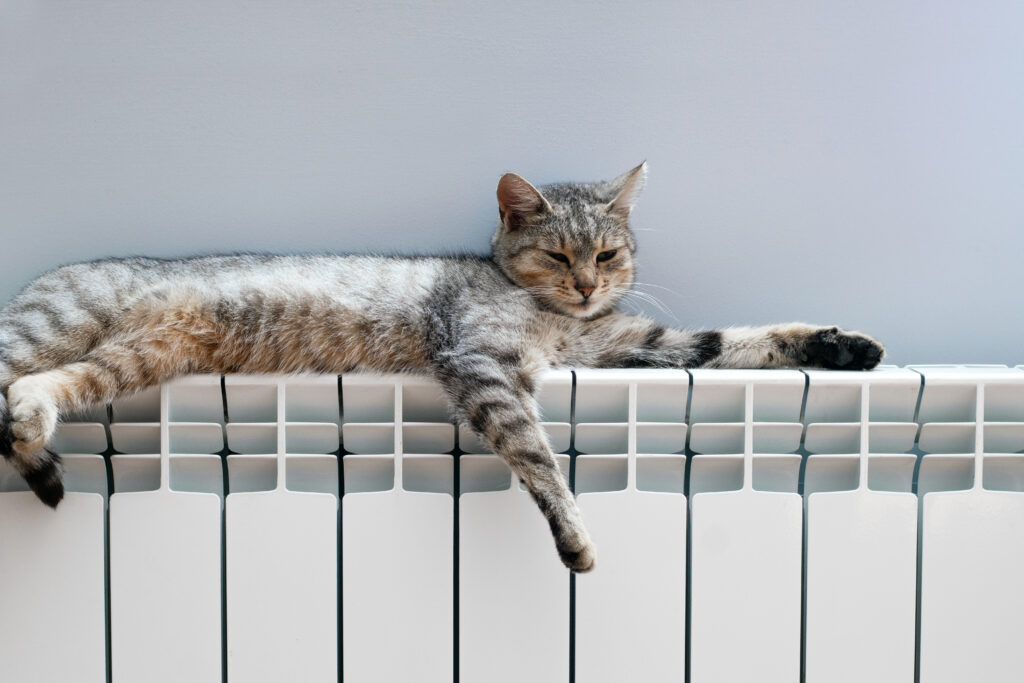
The monorail position is when a cat takes a nap on narrow surfaces like the arm or back of a couch, occasionally with one or more legs hanging off, like a monorail tram. This behavior is similar to how wild cats rest on the branches of tall trees, providing them with a sense of security and comfort. Moreover, it allows them to respond quickly if needed and might also be a way to stay close to you if you often relax on the couch.
Perching on the Furniture or Appliance

Although it may appear dangerous when a cat sleeps on the back of a couch, the arm of a chair, or even on top of the refrigerator, this sleeping position offers certain advantages. It provides them with a high vantage point, keeping them safe from potential threats like other pets, children, or unfamiliar visitors in your home.
Moreover, this perched position allows cats to watch over their surroundings, making it easier to spot potential “prey.” Cats may choose to sleep in such places to satisfy their inner hunter instincts and be prepared to bounce at any moment.
The Tucked-In
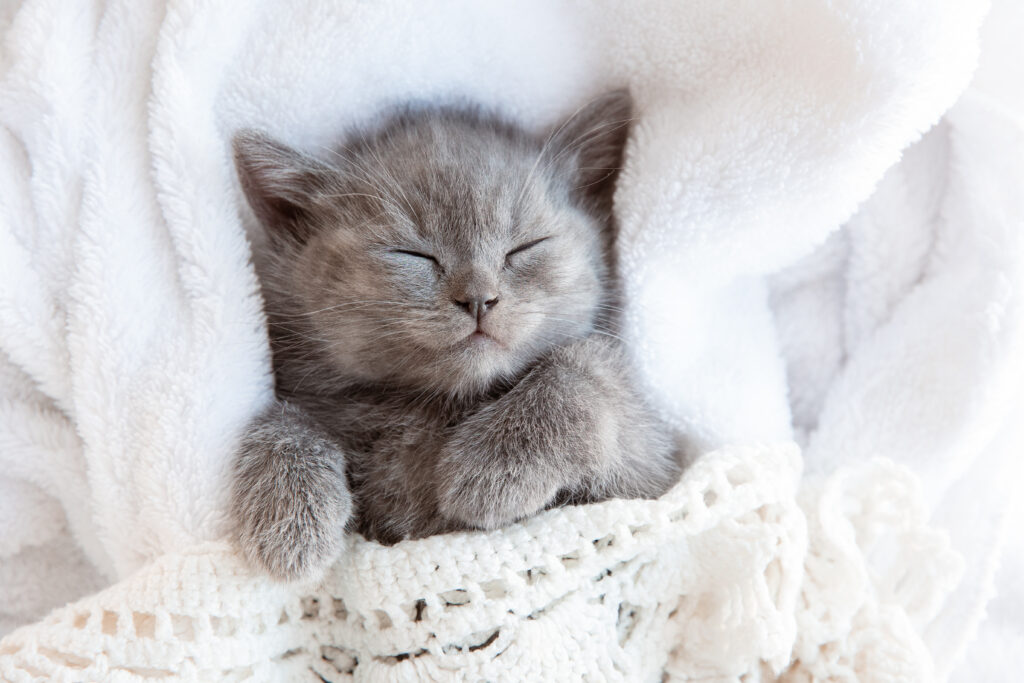
Cats who sleep under the covers do so for warmth, comfort, and the familiar scent of their human. It’s generally safe, but check to make sure the covers are breathable, as some cats burrow with only their noses out for quietness, warmth, and security.
The Acrobat/Contortionist
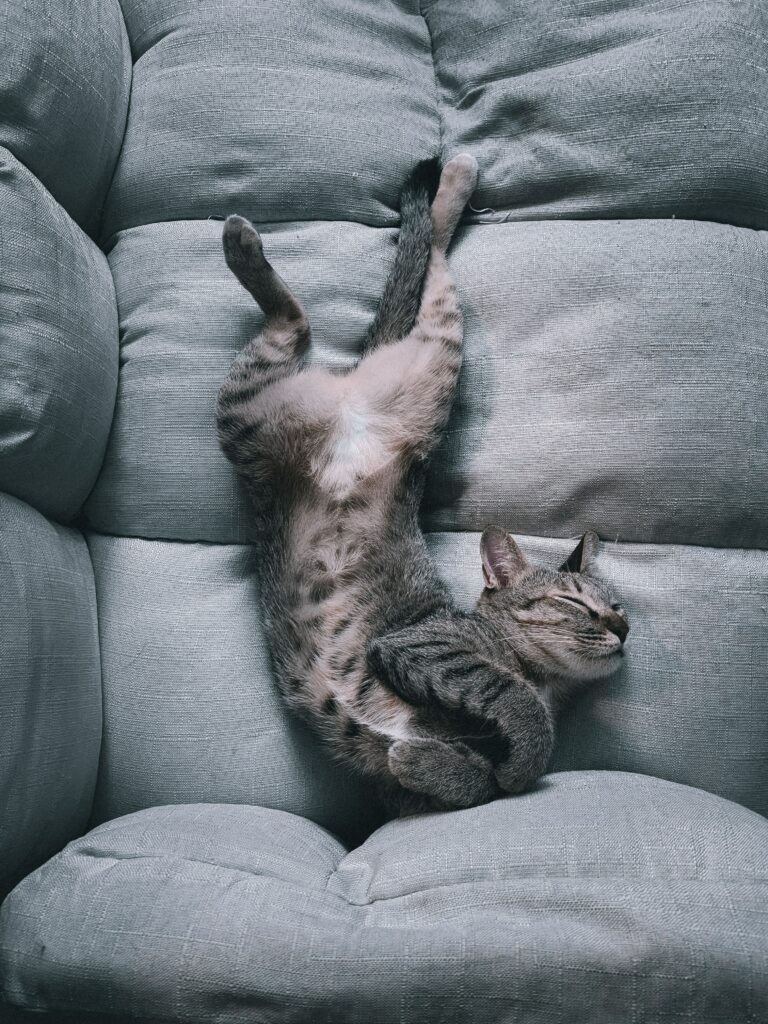
Cats sometimes sleep in peculiar positions, twisting their bodies and limbs into strange angles, but if they appear comfortable and relaxed, let them be. No one knows why cats assume these odd sleeping poses for sure, but it undeniably looks adorable. Cats are able to twist into these unique positions due to their flexible spinal columns and loosely attached shoulder blades, allowing them to find their own cozy and comfortable positions for rest.
Sleeping on Humans
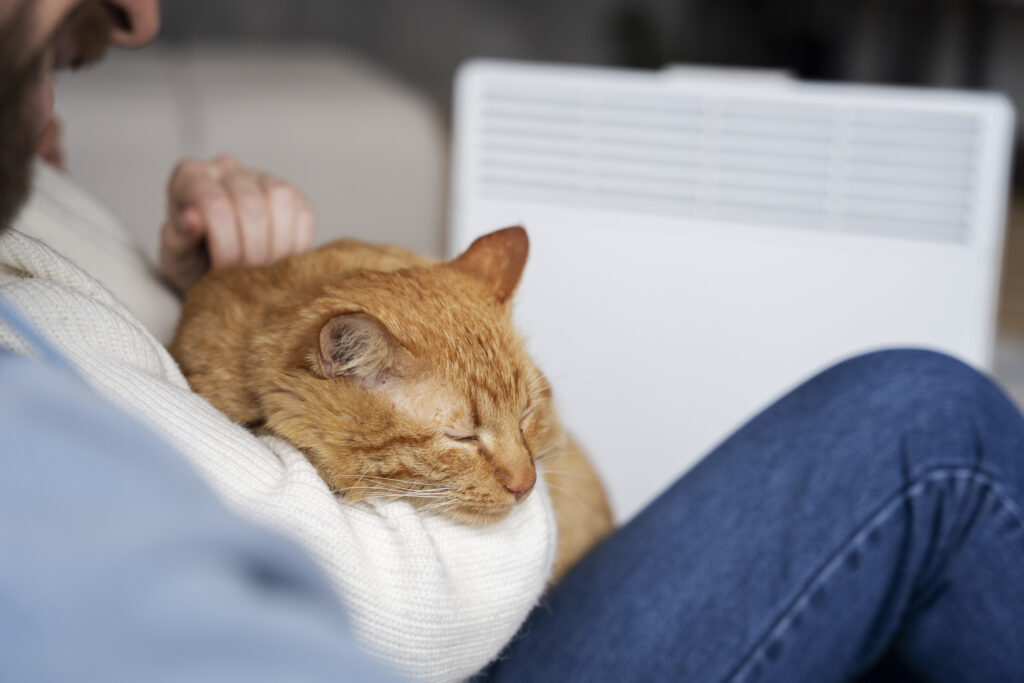
Next to You or Your Head
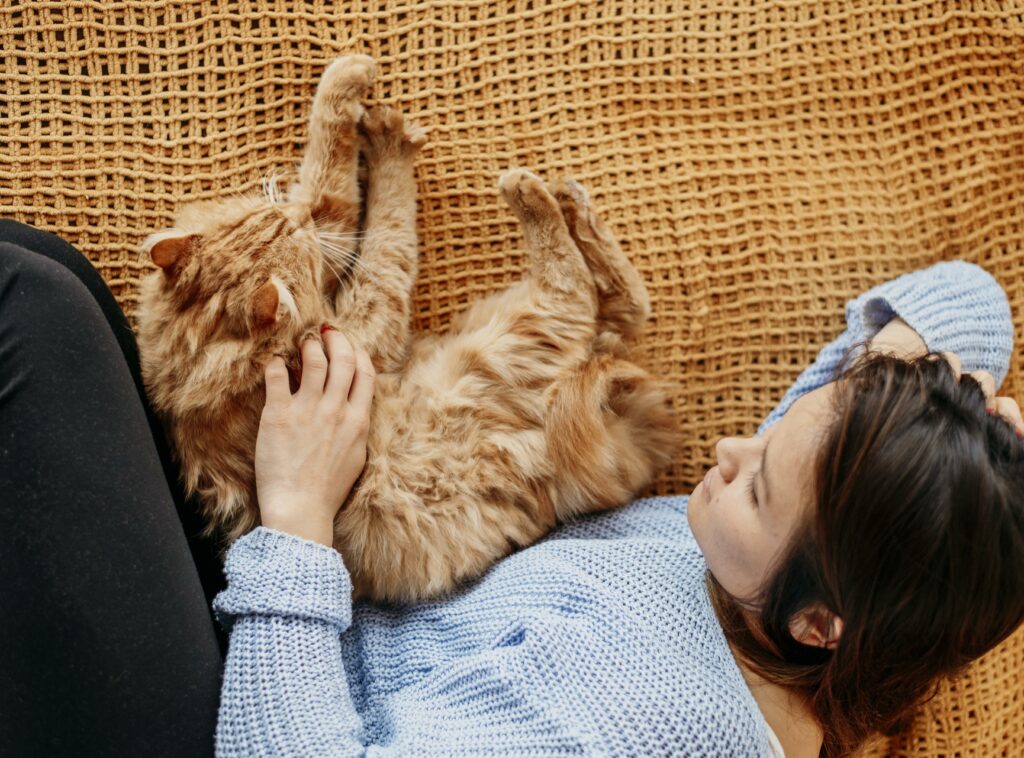
When your cat sleeps beside you or above your head but not on you, it’s not a sign of a lack of bonding. In fact, it signifies trust and comfort. Your cat chooses to maintain a slight distance, indicating a strong bond but a need for personal space at that moment.
Your feline friend may snuggle up next to you to feel secure, showing their trust in your presence. Sometimes, they might even position themselves with their backs to you, watching the environment to ensure your safety. For some cats, sleeping next to their human but with a bit of buffer space is their way of enjoying your company while still valuing their personal space.
Cats that sleep near your head are often drawn to the warmth and the rhythmic sounds of your breathing and heartbeat. This position allows them to stay alert to their surroundings while you rest.
On Your Chest
Cats sleeping on their humans, whether it’s on their chest, lap, or stomach, can be absolutely adorable. There are several reasons your cat might choose to do this.
Firstly, if your cat is bonded to you, they may want to sleep on your chest to be close to you. It’s a way of seeking comfort and warmth.
Also, the rhythmic sound of your heartbeat and the gentle motion of your breathing can have a soothing effect on cats, much like how these sounds can calm an infant.
Finally, resting on you gives your cat a wonderful body heat source. So, when your kitty chooses to sleep on your chest, it’s their way of seeking security, warmth, and the comfort of your presence.
At Your Feet
When your cat sleeps at your feet, it’s a heartwarming gesture that serves two purposes. First, it keeps your feet toasty, providing a cozy benefit for you. Second, your cat is seeking warmth from your presence, which can be particularly comforting during colder times. This closeness enhances your bond while your cat enjoys the warmth of your body.
This sleeping position is a genuine expression of affection from your feline companion.
Sleeping with Dogs

Cats and dogs can get along peacefully if introduced properly. They are not natural enemies, as some popular media may have suggested. When your cat sleeps with your dog, it often means they’ve formed a bond and seek companionship and warmth. This harmonious coexistence results from patient and gradual introductions of both parties.
Sleeping with Other Cats
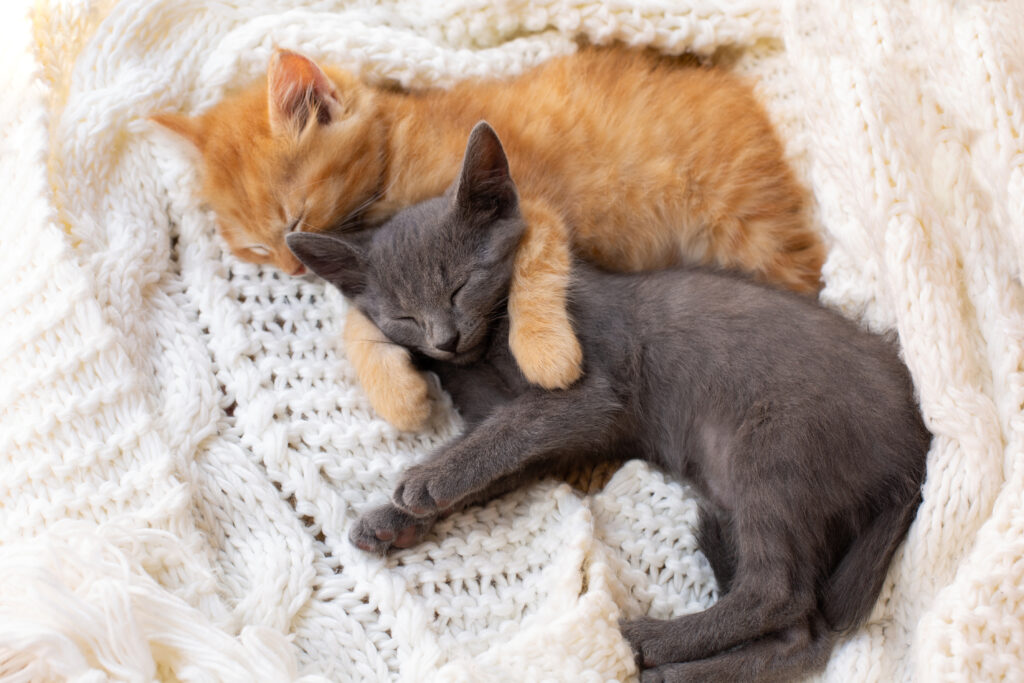
Cats living together can have different relationships. Some enjoy each other’s company and may sleep together for warmth and comfort, especially if they are bonded. Cats in the same social group may also sleep in close contact. Kittens often bundle up for warmth and safety, and this habit can continue into adulthood. If your cats sleep together like a pile, it signifies their companionship and bond. However, some cats merely tolerate each other and sleep nearby to convey a peaceful coexistence.
Sick Cat Sleeping Positions
Pay attention to the following sleeping positions of your cats. It might be a sign of your cat being unwell. If you notice any changes in your cat’s sleeping positions, it’s best to consult with a vet.
Face Down
Cats sleeping face down often do so to stay low and hidden from potential predators. It can also be a way for them to stay warm and signal that they prefer to be left alone. If your cat frequently sleeps in this position, consider providing them with a cozy and private sleeping spot where they can feel safe and secure.
However, this position can sometimes mean illness. If your cat presses their face to the ground while hunched over, watch for other signs of sickness like loss of appetite, lethargy, seizures, head tilt, or weakness. These symptoms may point to potential health issues such as organ failure, poisoning, or infection.
Hiding Away
Many cats value their personal space and prefer safe, cozy spots for napping. When a cat feels stressed or anxious, they might seek comfort in hard-to-reach hiding places, so it can be hard for owners to find cats sometimes.
However, if your cat is hiding more frequently than usual, especially sleeping or resting in unusual spots, do keep an eye on their eating, drinking, urination, and defecation habits. If you notice significant changes in any of these behaviors, it’s advisable to consult a vet to rule out any underlying medical issues.
Hunched/Crouched Posture
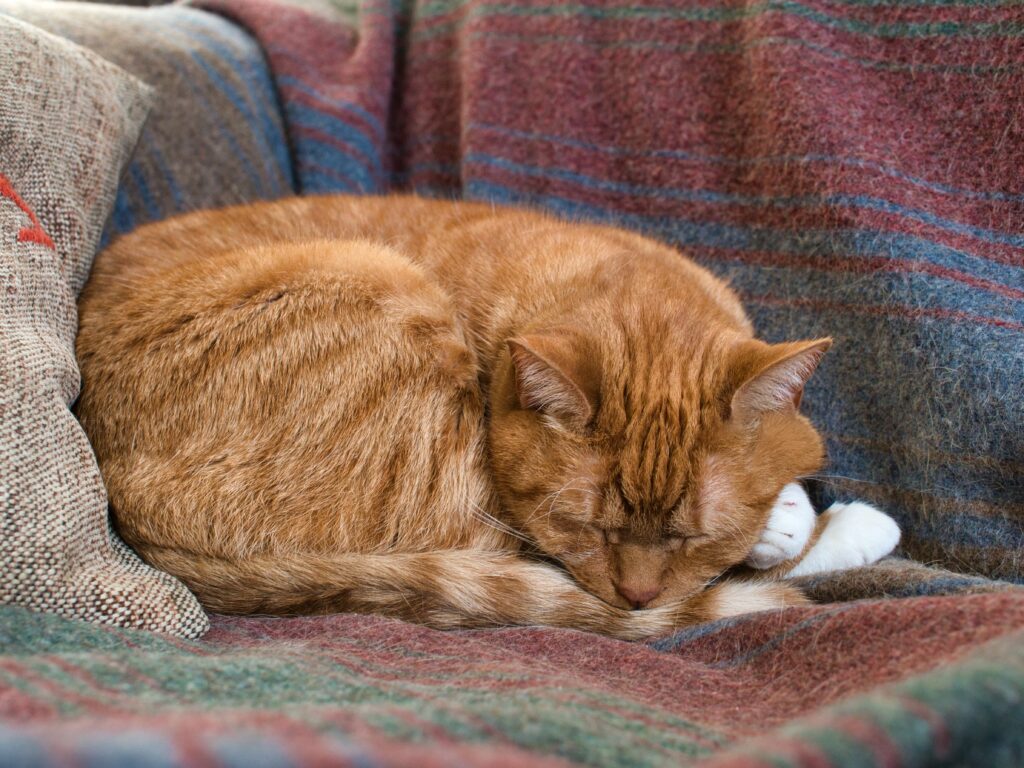
When a cat feels unwell, they may exhibit various signs of discomfort. These can include a tense body posture with a hunched back and a head tilted downward, even when it is sleeping. Ears may be rotated outward, whiskers straight or away from their face, and their coat could appear dull or matted due to reduced grooming.
Stay the Same Positions
Cats frequently change sleeping positions to avoid detection by predators. So, it can be concerning if a cat stays in one position for an extended period. A sick cat may lack the energy to change positions and might sleep quietly while hunched. In such cases, watch for signs like excessive purring, reduced grooming, or labored breathing, which may indicate a need for a health checkup.
A Cat Sleeping Position Chart
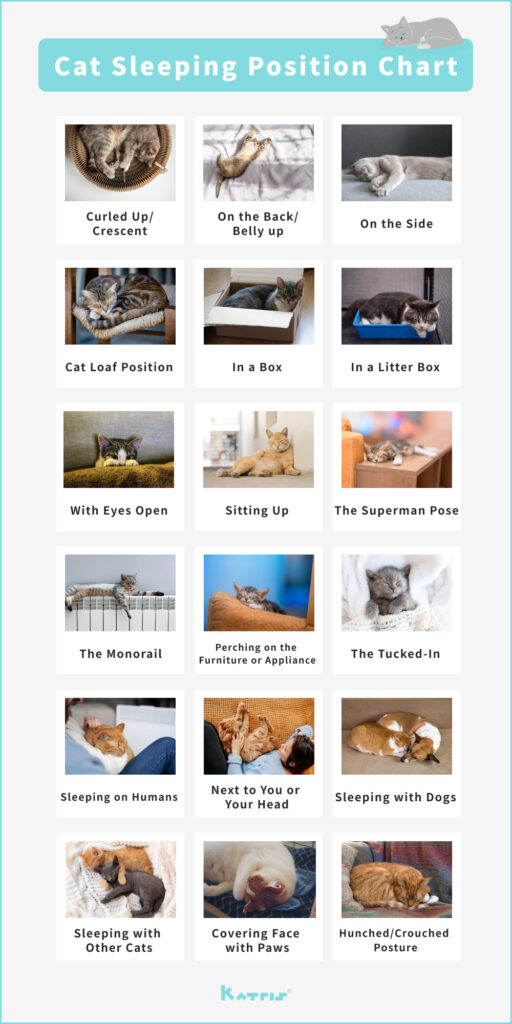
Solving the Mystery of Cat Sleeping Habits
We all know our feline friends are fans of sleeping, but how much time do they spend in dreamland? Here, we gather some of the most-asked questions about cats’ sleeping habits. Let’s find out more about the secrets of sleeping cats!

So… Why Do Cats Sleep So Much?
Cats are known for their love of sleep. But why do they sleep so much? The answer lies in their wild ancestry. Cats are natural predators, and hunting requires a lot of energy in the wild. To conserve this energy, cats sleep for long periods. Even though domestic cats don’t need to hunt for their food, this instinct for the hunt carries on, leading to long hours of sleep.
How Many Hours A Day Do Cats Sleep?
On average, cats sleep for about 13 to 14 hours a day. However, this can vary depending on the cat’s age and health. Kittens and older cats tend to sleep more than young adult cats. It’s not uncommon for a cat to sleep up to 16 hours a day, especially in their golden years.
When Do Cats Sleep During the Day?
Cats are crepuscular, meaning they are most active during dawn and dusk. This trait has carried over from their wild ancestors, who hunted most effectively during these times when their prey was most active. As a result, you’ll often find your cat snoozing during the day and becoming more active in the early morning and late evening.
The Stages of Sleep: A Cats Sleep Cycle
Much like humans, cats undergo various sleep stages, including Rapid Eye Movement (REM) sleep and Non-REM sleep. These stages contribute to their overall sleep cycle, enabling them to experience a combination of deep, restful sleep and periods of dreaming. Here’s a more detailed guide on recognizing what stage of sleep your cat is in.
REM sleep is characterized by rapid eye movements, hence its name. During this stage, cats’ brains are highly active, and their bodies may exhibit twitching or occasional limb movements. It is during REM sleep that dreaming commonly occurs in cats. Just like humans, cats may engage in a range of dream-like activities, such as chasing imaginary prey or engaging in playful behavior. Their whiskers, paws, and even tails may exhibit slight movements, indicating their involvement in these dream scenarios.
On the other hand, non-REM sleep is a phase of deep and restorative sleep. This stage can be further divided into three sub-stages: N1, N2, and N3. N1 represents the lightest stage of sleep, where cats may still be somewhat alert and easily awakened. As they progress into N2 and N3, their sleep deepens, and it becomes more challenging to rouse them.
Cats experience physiological processes during non-REM sleep that promote physical restoration and growth. In this phase, their bodies repair damaged tissues, strengthen the immune system, and consolidate memories. Non-REM sleep is crucial for maintaining their overall health and well-being.
Do Cats Like Cat Sleeping Beds?
A cat sleeping bed is an extraordinary accessory designed to offer your feline friend a comfortable, relaxing place to doze off. These beds come in various shapes and sizes, catering to the unique sleeping habits of cats. They serve as a luxurious retreat for your cat, providing them with a sense of security and warmth.
Cats innately love cozy spaces, and a cat bed fits the bill perfectly. It provides them with their own space, away from the hustle and bustle of the household. This can incredibly benefit their overall well-being, offering them a sense of security and reducing stress.
DIY Cat Sleeping Bed
If you’re looking for a more personalized touch, DIY cat sleeping beds can be a great alternative to traditional sleeping beds. These beds can be made using materials readily available at home and can be customized to suit your cat’s preferences. Check out some ideas here.
Good for Any Sleeping Position: Katris Nest

One such product that stands out in the market is the Katris Nest. This bed is not just a sleeping spot for your cat; it’s a haven. The Katris Nest is made from high-density, eco-friendly materials, ensuring durability and comfort for your cat. Here are some key points on how the Katris Nest can contribute to a night of good sleep for your cat:
- Comfort: The Katris Nest is made from high-density, eco-friendly materials that provide a soft and comfortable surface for your cat to sleep on.
- Security: The unique design of the Katris Nest gives your cat a sense of security, which can contribute to a more restful sleep.
- Warmth: The enclosed design of the Katris Nest helps keep your cat warm, especially during colder months.
- Privacy: The Katris Nest provides a private space for your cat to retreat to, which can help reduce stress and promote better sleep.
- Versatility: The Katris Nest is suitable for all sleeping positions, ensuring that your cat can find a comfortable position to sleep in.
- Aesthetics: The stylish design of the Katris Nest not only adds aesthetic value to your home but also provides a cozy and inviting space for your cat to sleep in.
What sets the Katris Nest apart from typical cat beds is its design. It’s not just a bed; it’s a piece of furniture that fits seamlessly into your home and style. It’s a one-of-a-kind product that not only provides comfort for your cat but also adds aesthetic value to your home.
So, if you’re looking to spoil your feline friend with a luxurious sleeping spot, the Katris Nest is the way to go. Check it out here.



